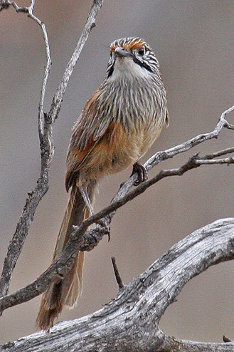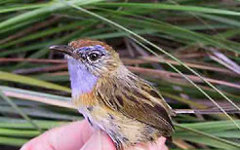The Bushfires Royal Commission plan of increasing "controlled burning" in the Mallee is an example of a one-size-fits-all mentality.
Birdlife including the Mallee emu-wren and black-eared miner, both of which are endangered, and threatened marsupials such as the western pygmy possum, face a dramatic loss of habitat if the commission's advice to triple the rate of prescribed burning to 5 per cent of public land each year is followed.
Bushfire proposal threatens Mallee wildlife: scientists (The Age, 20 Dec)
It would threaten the long-term survival of the region's native wildlife, a scientific study has found.
A four-year study, led by Professor Clarke of Latrobe University and Professor Andrew Bennett of Deakin University, found that large parts of the Mallee have not burned for between 20 and 140 years.
The Mallee has been recognised as the most threatened environment for birds in Australia.

Image source: Wikimedia commons
The Striated Grasswren is a little bird with rich and varied songs, and require large clumps of spinifex to hide in. The size is only suitable 25-40 years post-fire. Tree hollows, needed by many kinds of animals for nesting or roosting, take at least 40 years to develop in mallee.

Image source: SA Government
Mallee Emu-wren (Stipiturus mallee) is one of Australia’s smallest birds, weighs up to 6.5 grams. It uses its size to great advantage to move quickly through dense shrubs, darting about amongst the very prickly spinifex. Very large or frequent fires can eliminate these birds from large areas, leaving them isolated in small, scattered locations, unable to escape further fires. It is globally endangered.
Large fires burn thousands of hectares and dramatically change vegetation and wildlife habitats.
Professor Clarke said the Baillieu government needed to respect the unique characteristics of the Mallee in managing fire risk.
The Flora and Fauna Guarantee Act (FFG) and Environment Protection and Biodiversity Conservation (EPBC) Act should be used to override the Bushfires Royal Commission and stop any actions that further threaten species and their habitats.
Department of Sustainability and Environment (DSE) chief fire officer Ewan Waller said the program would be the biggest in recent years, weather permitting. Burning is by far the best way to manage fuel loads within our forests and give protection to Victorian communities, Mr Waller said. What about species who make homes in this "fuel load"? "Victorian communities" are more than humans!
Ecological sensitivities and endangered wildlife are just left to be collateral damage!
This year is the International Year of Biodiversity, and it is not too late for some real action to protect some diminishing native species.
Copies of the Mallee Fire and Biodiversity Project are available here.
Contact:
Ewan Waller
Phone: 03/9412 4777
Fax: 03/9650 8575
4th Floor 8 Nicholson Street
EAST MELBOURNE, 3002
VIC
[email protected]
http://www.dse.vic.gov.au/fireURL
Ted Baillieu
Phone(03) 9882 4088
[email protected]
325 Camberwell Road, Camberwell 3124
Department of Sustainability and Environment
[email protected]
Call 136 186 from anywhere in Australia for the cost of a local call

Comments
Enne K (not verified)
Wed, 2010-12-22 15:09
Permalink
Environmentally illiterate leaders
Add comment